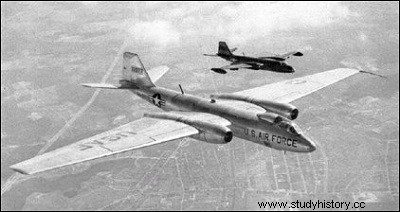
Airplane :Martin RB-57D Canberra.
Manufacturer :Glenn L Martin Co.
Type :acknowledgement.
Year :1955.
Engines :two Pratt &Whitney J57-P-5 turbojet engines of 4,990 kg thrust each.
Wingspan :32.30 m
Length :, 19.96 m.
Height :4.52 m.
Take-off weight :24,948 kg.
Maximum speed :936 km/h at 12,190m altitude.
Maximum operating altitude :14,630 m.
Crew :2 people.
The most agile light bomber ever. In 1977, aeronautical specialists applied this definition to the B-57 Canberra, still in service at that time nearly thirty years after the first flight of the prototype. In the roles of assault and reconnaissance aircraft, this twin-engine aircraft of British origin demonstrated its incomparable value within the USAF and its brilliant operational employment brought an irrefutable denial to all those who, in the early fifties, had viewed with suspicion the decision to adopt a combat machine not produced by the United States.
The Americans made this decision in 1951. At that time, the USAF was looking for a good attack aircraft and, given the failure of the Martin XB-51 project of 1949, found in the excellent characteristics of the British bomber English Electric Canberra the best response to his requirements.
In particular, the English aircraft demonstrated great agility and flexibility in operations, had exceptional maneuverability and had an autonomy and a very valid war load capacity.
From then on, the United States chose to have a version of the British aircraft produced under license by Martin. The first of these planes with the insignia of the United States arrived in Baltimore (the headquarters of Martin, in Maryland) directly from Great Britain. It was an original Canberra 8.2 which left Aldergrove (Northern Ireland) on February 21, 1951 and reached Newfoundland in a non-stop flight of 4 hours 37 minutes. It thus went down in history as the first jet to have managed to cross the Atlantic without having to be refueled.
From this machine, the Martin started an initial production program and built 8 preproduction B-57As, essentially identical to the British prototype except for a few construction details and engines, two Wright J65s of 3,275 kilos of thrust.
The first 8-57A flew on July 20, 1953 and, following the initial production, 67 RB-57As followed, intended for reconnaissance but, in fact, identical to the pre-production aircraft, which began to arrive in detachments in April 1954.
Two months later flew the prototype of the second model B-578, the role of which was to carry out night raids. These aircraft presented the first significant modifications compared to the original English version:the most obvious was the adoption of a cockpit able to accommodate the two crewmen no longer side by side but in tandem.
The engineers also modified the armament and installed eight machine guns (or four 20 millimeter cannons) in the wings, transforming the plane to allow it to carry rockets.
On January 5, 1955, the first examples of the 202 B-57Bs produced began to equip operational detachments and remained in front-line activity there until 1961. At the same time, 38 8-57Cs entered service intended for training. and 68 B-57Es used for target towing.
Martin also extensively revised the designs of the basic type to build the 20 reconnaissance examples, called RB-57Ds and characterized by much longer wings, in order to improve performance at high altitude, and by installing different thrusters (Pratt &Whitney J57).
These machines were used not only for photographic reconnaissance but also for hunting thanks to a system of electronic countermeasures. In 1963, all were grounded because the structures showed obvious signs of fatigue. This boredom led to the creation of another high-altitude reconnaissance version, the RB-57F, 21 of which were built by General Dynamics. Fitted with extensively modified wings, fuselage, lift planes and on-board equipment, these Canberras enjoyed a long and intense operational career. The latest version, the B-57G, actually resulted from the transformation of many examples of the initial models, adapted to more modern equipment standards.
